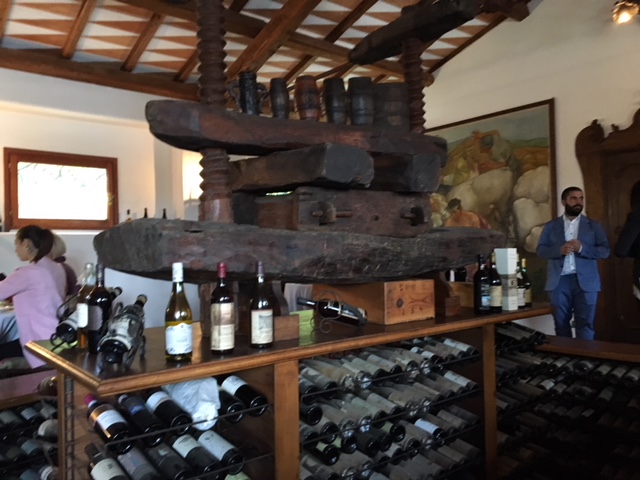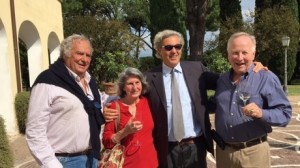If you had asked me before a recent visit to Rome what the wines from Lazio (the region that includes the city of Rome) were like, I would have replied that they were very average at best. The white wine was almost always Frascati, a blend of 70% Malvasia del Lazio or Malvasia Bianca di Candia and 30% some type of Trebbiano or other local white grape. The red wines were generally Sangiovese.
Today, my answer would be very different. My wife and I had the pleasure of visiting the Azienda Agricola Casale del Giglio, a 180 hectare vineyard and winery located about 50 km south of Rome. Casale del Giglio is owned by Signor Antonio Santarelli, the third generation proprietor who directs the operation. Casale del Giglio was started in 1967 on land that had been reclaimed in the 1930s from swampland by the Italian government. Before 1967, the Santarelli family had been in the wine and olive oil business in Rome since 1914.
Because there was no previous history of viniculture on this reclaimed land area, the Santarelli family was free to experiment. Together with winemaker Paolo Tiefenthaler, a native of Trentino, the family Santarelli launched a project in 1985 to find grapes that grew best in this soil. They planted 60 different types of grapes, both native Italian types as well as grapes from other countries. Aided by several wine academicians from universities all over Italy, the project yielded the grapes that today make up the various wines offered by Casale del Giglio.

Casale del Giglio.
Next we tried a 2017 Lazio IGT Chardonnay, another 13% alcohol wine that was made from 100% Chardonnay grapes grown from densely planted (4,000 vines /hectare). It was chilled and stored in stainless steel tanks for 3-4 months before bottling. The Chardonnay was pale yellow in color with a light fruit nose. It finished medium long and very smooth. I rated this excellent example of non-oaked Chardonnay 89.
The third wine was a 2017 Lazio IGT Sauvignon, a 100% Sauvignon Blanc 13% alcohol wine. The Sauvignon grapes were soft pressed and fermentation was immediately activated to capture the traditional Sauvignon aroma. The wine was cooled to 8°C to prevent malolactic fermentation. After stabilization, the wine was bottled in the first two months of the year. The product of this process was pale yellow in color with a light elegant Sauvignon nose. This French type of sauvignon finished medium and smooth and I rated it an 89.
Next we tried a 2017 Lazio IGT Viognier, a 100% Viognier grape 13.5% alcohol wine. Produced from a combination of ripe and over-ripe grapes, the grapes undergo 8-10 hours cold maceration followed by soft pressing. Spontaneous fermentation lasts for around 10 days at a temperature of 17/18 °C. The wine is stored on its lees in stainless steel tanks at 8-10°C to prevent malolactic fermentation. After about 6 months aging in the tanks the Viognier is bottled. The product was a pale yellow in color and had a light fruit nose. It finished a bit short but smooth. I rated this wine an 87.
Continuing in the vein of French varietals transposed to Lazio, our next wine was a 2017 Lazio IGT Petit Manseng, a 13.5% alcohol 100% Petit Manseng grape wine. This grape, native to the foothills of the French Atlantic Pyrenees mountains, is a late autumn harvest. The grapes are crushed and de-stemmed, then chilled at 7-8°C and allowed to macerate for 10-12 hours. Next they are soft pressed and sedimentation takes place at 14-16°C. Spontaneous fermentation begins and yeasts are added on the second day. After ten days the new wine is racked and cooled to prevent malolactic fermentation, and after several months on the lees, the wine is bottled in early spring. The Petit Manseng was yellow in color with a very light nose. It finished medium long and I rated it an 89. This wine would be great with seafood.
Still in white wines we next tried a 2016 Lazio Bianco IGT Antinoo, a wine named for the Roman Emperor Hadrian’s favorite Greek sculpture. The Antinoo, a 70% Viognier and 30% Chardonnay blend had an alcohol content of 13.5%. It was very pale yellow in color with a light nose. The wine finished medium long and very smooth. I really liked this wine and rated it a 90. It will age well for a white wine.
Our last white wine was a 2017 Lazio Bianco IGT Anthium 14% alcohol wine. Made from 100% Bellone grapes, a type native to this region in Italy, the grapes are high in acidity and sugar, both aided by the sea breezes. Two stages of vinification take place with maceration on the skins for flavor extraction followed by soft pressing. Spontaneous fermentation then occurs with indigenous yeasts for 10-12 days at 18-20°C. The Anthium was yellow in color with a light but complex nose. It finished medium with good body and nice acidity. It is suitable for bottle aging. I rated this wine an 89.
Leaving the white wines, we tried a 2017 Lazio Rosato IGT Albiola, a 12.5 % alcohol rosé made from 85% Syrah and 15% Sangiovese grapes. The grapes are gently crushed and left standing in stainless steel tanks for several hours. After an initial period of cold maceration on the skins at 8-10°C, some of the juice is drained off and fermented separately. Fermentation takes place in stainless steel vats with temperature of 18°C for 8-10 days. The resulting wine was pale pink in color with a light fruit nose. It finished light and fruity, a very nice rosé. I rated this wine an 89.
Our first red was a 2016 Lazio IGT Merlot. This 100% Merlot, 13% alcohol wine used submerged cap pump-over which permitted 15-20 days of maceration time. Malolactic fermentation was in stainless steel tanks with aging for 8-12 months in small oak barrels. After bottling it received further aging in the bottle for six months. The result was a garnet color wine with a typical Merlot nose. It finished medium and smooth and I rated it an 89.
Next we tried a 2016 Lazio IGT Shiraz made from 100% Syrah grapes. This 13% alcohol wine received two days of cold maceration at 10°C. The fermenting must was racked several times during the 10-12 day fermenting process at 26-28°C. An aging period of 8-12 months in barriques followed with a further 6 months in the bottle. The result was a wine of garnet color with a leather and fruit nose. It finished medium and smooth. I rated this wine an 89/90.
Casale del Giglio has two signature red wines. Madreselva, a Lazio Rosso IGT wine is a 14 % alcohol equal blend of Merlot, Cabernet Sauvignon and Petit Verdot grapes. Separate vinification for each variety was conducted. When malolactic fermentation was completed the individual wines were aged in small oak casks for 18-20 months and after racking were blended together, bottled and further aged in the bottle for 8-12 months. The result was a wine ruby red in color with a slight fruit nose. It finished long and very smooth and I rated this excellent wine a 92.
The second signature red was a 14% alcohol Mater Matera, a Lazio Rosso IGT blend of 85% Syrah and 15% Petit Verdot. The Syrah was vinified by the submerged cap method fermenting on native yeasts for 18-20 days. The Petit Verdot used the punching down method which maximizes extraction of tannins and polyphenols, thus giving the wine its aging potential. The wines were separately aged for 22-24 months in oak and then blended, bottled and further aged for another 10-12 months. The result was a deep garnet colored wine with a complex nose. It finished very long and smooth. I rated this elegant wine a 93.
Amazingly, these are not all of the wines offered by Casale del Giglio. We had the pleasure of trying Casale del Giglio’s Petit Verdot, a 100% Petit Verdot (yes, it exists) with an excellent meal at their restaurant, Collegio, in Rome (Piazza Capranica 99, tel 06 6994 0992).

L. to R: Carlo Fusacchia, Terry Duarte, Antonio Santarelli, Neil Duarte.




